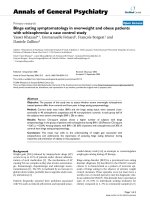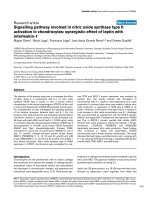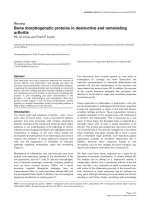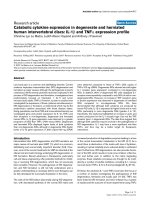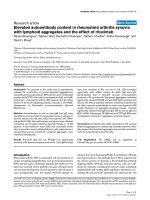Báo cáo y học: " Nitric oxide synthases in infants and children with pulmonary hypertension and congenital heart disease" ppsx
Bạn đang xem bản rút gọn của tài liệu. Xem và tải ngay bản đầy đủ của tài liệu tại đây (422.18 KB, 9 trang )
BioMed Central
Page 1 of 9
(page number not for citation purposes)
Respiratory Research
Open Access
Research
Nitric oxide synthases in infants and children with pulmonary
hypertension and congenital heart disease
Thomas Hoehn*
1
, Brigitte Stiller
2
, Allan R McPhaden
3
and
Roger M Wadsworth
4
Address:
1
Neonatology and Pediatric Intensive Care Medicine, Department of General Pediatrics, Heinrich-Heine-University, Duesseldorf,
Germany,
2
Department of Congenital Heart Disease, University Hospital, Freiburg and Department of Pediatric Cardiology, Deutsches
Herzzentrum, Berlin, Germany,
3
Department of Pathology, Glasgow Royal Infirmary, Glasgow, UK and
4
Department of Physiology and
Pharmacology, University of Strathclyde, Glasgow, UK
Email: Thomas Hoehn* - ; Brigitte Stiller - ;
Allan R McPhaden - ; Roger M Wadsworth -
* Corresponding author
Abstract
Rationale: Nitric oxide is an important regulator of vascular tone in the pulmonary circulation.
Surgical correction of congenital heart disease limits pulmonary hypertension to a brief period.
Objectives: The study has measured expression of endothelial (eNOS), inducible (iNOS), and
neuronal nitric oxide synthase (nNOS) in the lungs from biopsies of infants with pulmonary
hypertension secondary to cardiac abnormalities (n = 26), compared to a control group who did
not have pulmonary or cardiac disease (n = 8).
Methods: eNOS, iNOS and nNOS were identified by immunohistochemistry and quantified in
specific cell types.
Measurements and main results: Significant increases of eNOS and iNOS staining were found
in pulmonary vascular endothelial cells of patients with congenital heart disease compared to
control infants. These changes were confined to endothelial cells and not present in other cell
types. Patients who strongly expressed eNOS also had strong expression of iNOS.
Conclusion: Upregulation of eNOS and iNOS occurs at an early stage of pulmonary hypertension,
and may be a compensatory mechanism limiting the rise in pulmonary artery pressure.
Introduction
Nitric oxide (NO) plays a central role in the maintenance
of normal pulmonary vascular tone and healthy lung
function [1]. All 3 isoforms of nitric oxide synthase (NOS)
are present in the lungs and contribute to NO production
in specific cell types [2]. Pediatric pulmonary disease is
associated with endothelial dysfunction and conse-
quently reduced NO delivery from the pulmonary vascu-
lar endothelium [3]. Moreover there is evidence from
experimental models of neonatal pulmonary hyperten-
sion that impairment of NOS can generate reactive oxygen
species, leading to a further cycle of deterioration of the
vascular endothelium [4]. In adults with pulmonary arte-
rial hypertension it has been demonstrated that output of
NO is diminished [5], and that those patients who
responded well to therapy had corresponding improve-
Published: 13 November 2009
Respiratory Research 2009, 10:110 doi:10.1186/1465-9921-10-110
Received: 21 July 2009
Accepted: 13 November 2009
This article is available from: />© 2009 Hoehn et al; licensee BioMed Central Ltd.
This is an Open Access article distributed under the terms of the Creative Commons Attribution License ( />),
which permits unrestricted use, distribution, and reproduction in any medium, provided the original work is properly cited.
Respiratory Research 2009, 10:110 />Page 2 of 9
(page number not for citation purposes)
ment in exhaled NO [6]. NO status can be improved by
administration of inhaled NO which is valuable in the
management of infants with pulmonary hypertension [7-
10].
We chose to immunohistochemically investigate changes
in NOS expression during the early course of pulmonary
hypertension. Studies with experimental models of pul-
monary hypertension have shown upregulation of
endothelial NOS (eNOS) in the endothelial layer of both
large and small pulmonary arteries [11]. Increased expres-
sion of eNOS was due to the initiating stimulus (hypoxia)
and was not secondary to hyperperfusion [12]. The upreg-
ulation of eNOS correlated in time with the development
of pulmonary hypertension [13]. In cultured pulmonary
endothelial cells, acute exposure to hypoxia also upregu-
lated eNOS [14]. There are several molecular mechanisms
through which hypoxia can stimulate eNOS accumula-
tion in endothelial cells, including hypoxia inducible fac-
tor [15] and phosphorylated cyclic-AMP response element
binding protein (pCREB) [16]. Others have shown
decreased expression of eNOS during chronic hypoxia in
rats [17] and in human endothelial cells [18]. However in
patients with pulmonary hypertension, it is less clear what
changes in NOS isoform levels occur. In infants with con-
genital diaphragmatic hernia, it has been reported that
pulmonary endothelium levels of iNOS were decreased
[19] or unchanged [20], and similarly that pulmonary
vascular endothelium levels of eNOS were decreased [21]
or unaltered [19,20]. In adults with primary or secondary
pulmonary hypertension, eNOS was reduced in the
endothelial layer of small pulmonary arteries [22,23] but
increased in plexiform lesions [22]. Given that the clinical
studies have used patients with advanced disease whereas
the experimental animal studies looked at an early stage
of relatively mild pulmonary hypertension, we hypothe-
sised that eNOS is raised initially when pulmonary hyper-
tension is developing but falls at a late stage when
endothelium dysfunction becomes severe. The aims of the
present study were therefore to immunohistochemically
determine the expression of the three isoforms of NOS in
the lungs of infants with secondary pulmonary hyperten-
sion since they will have been exposed to elevated pulmo-
nary pressure for a relatively short time and may therefore
reveal what happens during the development of pulmo-
nary hypertension.
Methods
Patients
Patients (n = 26) had a mean age of 16.9 months (± SEM
= 4.02, median = 11 months, range: 2 months to 7 years)
and had cardiac surgery performed between December
1985 and October 1991 at the German Heart Institute,
Berlin, Germany. All patients had congenital cardiac
defects typically associated with pulmonary hypertension
and had a lung biopsy taken during corrective cardiac sur-
gery. Surgery markedly reduced systolic pulmonary artery
pressure with further reduction at follow up in patients,
from whom data were available (for patient details see
Table 1). Informed consent was obtained from the
infants' parents, and the study protocol had previously
been approved by the local institutional ethics committee.
Control subjects
Control infants (n = 8) were chosen from infants and chil-
dren having died from various non-pulmonary causes,
who had an autopsy performed at the Department of
Paidopathology, Humboldt University Berlin, Germany.
None of these patients had clinical or echocardiographic
evidence of pulmonary hypertension nor was there any
clinical or radiologic evidence of pulmonary infection.
Controls had a mean age of 7.1 months (± SEM = 1.75,
median: 6 months, range: 2 to 17 months). For control
details see Table 2.
Methodology for immunohistochemistry
Lung tissue was supplied as paraffin-embeded tissue
blocks. Sections (4 μm) were cut from the blocks, rehy-
drated and then treated for antigen retrieval by microwave
pressure cooking or trypsin incubation. The sections were
then treated to block non-specific binding of primary and
secondary antibodies and non-specific reaction with chro-
mogens as described previously [11]. Sections were then
incubated with the specific antibody for 60 minutes at
room temperature (eNOS: catalogue reference 610296,
BD Biosciences, UK, used at 1:1000 dilution along with
pressure cooking antigen retrieval; iNOS: catalogue refer-
ence 610328, BD Biosciences, UK, used at 1:500 dilution
along with pressure cooking antigen retrieval; nNOS: cat-
alogue reference 610308, BD Biosciences, UK, used at
1:400 dilution along with trypsin antigen retrieval).
Bound antibody was detected using goat anti-mouse IgG
conjugated with horseradish peroxidase using a streptavi-
din-biotin link, and visualized with diaminobenzidine. In
negative controls the primary antibody was replaced with
pre-immune serum. Sections were counterstained using
hematoxylin and viewed by light microscopy.
Staining intensity was quantified as follows: 0 = negative;
0.5 = faint/blush; 1 = mild; 2 = moderate. Separate quan-
tification was performed for eNOS in small artery
endothelium, small artery media, respiratory epithelium,
alveolar macrophages. Antibody dilutions were chosen in
order to differentiate between groups i.e. although there is
usually baseline expression of eNOS in controls; dilutions
were titrated until there was no eNOS expression visible in
controls. For iNOS and nNOS, quantification was carried
out in the same cell types except that alveolar macro-
phages and alveolar lining cells were combined. Vessels of
Respiratory Research 2009, 10:110 />Page 3 of 9
(page number not for citation purposes)
Table 1: Patient details
dob sex Systolic
PA-pressure
pre-surgery
PVR dyn Systolic
PA-pressure
post-surgery
Systolic
PA-pressure
after 6-36
months
Qp:Qs Rp:Rs Diagnosis Age at surgery
(months)
Heath +
Edwards
Rabinovich
26.12.1990 f 75 1178 24 17 7,2 0,01 complete atrio-
ventricular septal
defect ventricular
septal defect, atrial
septal
52 a
28.03.1991 f 424 5 0,08 defect 6 2 b
20.01.1985 m 388 3 0,10 ventricular septal
defect ventricular
septal defect, atrial
septal
11 2 b
20.03.1984 m 160 1,6 0,11 defect 60 1 a
20.10.1987 f 968 3,9 0,15 ventricular septal
defect
12 2 c
03.12.1982 m 83 294 60 11 2,9 0,24 complete atrio-
ventricular septal
defect
84 1 c
12.08.1988 f 100 2400 30 22 2,6 0,27 complete atrio-
ventricular septal
defect ventricular
septal defect, patent
ductus
72 c
27.02.1991 f 1425 3,4 0,29 arteriosus,
coarctation
ventricular septal
defect, atrial septal
61 a
25.11.1988 f 1855 2,8 0,30 defect 5 1 b
17.01.1985 f 80 2059 25 30 1,5 0,32 complete atrio-
ventricular septal
defect
14 0 0
14.06.1988 f 75 2222 25 14 2,1 0,32 complete atrio-
ventricular septal
defect single vessel
disease, partial
anomalous
51 b
09.03.1984 f 1285 1,9 0,33 pulmonary venous
drainage
48 2 c
25.05.1990 m 2536 0,71 0,40 thoracic aortic
constriction double-
outlet right ventricle,
ventricular
21 b
Respiratory Research 2009, 10:110 />Page 4 of 9
(page number not for citation purposes)
17.10.1980 m 717 1,9 0,40 septal defect,
coarctation
11 3 c
06.04.1987 m 982 2,1 0,40 complete atrio-
ventricular septal
defect
19 1 c
15.05.1990 m 1883 35 2,3 0,41 ventricular septal
defect
72 b
13.05.1988 f 1509 1,8 0,43 ventricular septal
defect
11 2 0
10.02.1988 f 90 2061 38 18 1,8 0,45 complete atrio-
ventricular septal
defect
12 2 0
18.05.1990 f 3593 0,83 0,47 complete atrio-
ventricular septal
defect
41 a
22.09.1988 m 3537 1,2 0,50 atrial septal defect,
patent ductus
arteriosus
21 b
31.10.1989 m 2166 1,5 0,52 ventricular septal
defect
11 1 b
03.11.1989 m 2617 1,4 0,71 mitral incompetence 11 2 a
05.04.1987 m 100 2135 25 35 1,6 0,71 ventricular septal
defect
30 0 ?
06.10.1984 f 93 983 75 34 1 0,83 ventricular septal
defect
48 4 c
24.10.1988 f 83 2143 35 14 1,5 0,83 complete atrio-
ventricular septal
defect
62 b
25.05.1988 f 110 1888 40 1,3 0,90 ventricular septal
defect
34 ?
(CAVSD: complete atrio-ventricular septal defect; ASD: atrial septal defect; VSD: ventricular septal defect; MI: mitral incompetence); n = 26
Table 1: Patient details (Continued)
Respiratory Research 2009, 10:110 />Page 5 of 9
(page number not for citation purposes)
an internal diameter of less than 250 μm were regarded as
small pulmonary arteries.
Statistics
For each antibody and cell type, the staining intensity of
the cardiac patients was compared to the staining inten-
sity of the normotensive patients using the Mann-Whit-
ney-U test. Spearman's correlation coefficient has been
calculated to describe the correlation between eNOS and
iNOS expression. Statistical significance was assumed at p
< 0.05.
Results
In all of the lung sections from infants with pulmonary
hypertension, thickening of the small pulmonary arteries
was evident. In contrast there were no abnormalities of
the pulmonary arteries in any normotensive control
patients. There was expression of eNOS in the endothelial
layer of small pulmonary arteries, the respiratory epithe-
lium, and alveolar macrophages. Expression of eNOS was
greatly increased in pulmonary hypertensive lungs com-
pared to control lungs in the pulmonary artery endothe-
lium (Figure 1, Figure 2). However there were no
significant differences between controls and patient
groups in staining for eNOS in alveolar macrophages and
in the respiratory epithelium. Expression of iNOS was
found in the small pulmonary arteries, both media and
endothelium, the respiratory epithelium, and in alveolar
macrophages/alveolar lining cells. There was significant
upregulation of iNOS in endothelial cells of pulmonary
hypertensive patients compared to control patients, but
there were no differences between the cases and controls
at any of the other cell types where iNOS was found (Fig-
ure 1, Figure 2). Expression of nNOS was very light in all
cell types in the lung and was not different between cases
and controls (Figure 1, Figure 2).
There was a significant correlation of eNOS and iNOS
staining intensity in the pulmonary artery endothelium,
such that patients having stronger staining in eNOS also
had higher levels of iNOS (Spearman's correlation coeffi-
cient 0.72, p = 0.0004).
Discussion
Here we report the consistent finding of an increase in
eNOS expression during conditions of increased pulmo-
nary vascular resistance secondary to congenital heart dis-
ease in infants and children. This upregulation appears to
be linked to pulmonary hypertension in that it occurs in
the pulmonary artery endothelium, but not in other sites
where eNOS is present and nor is there any change in
nNOS. We have previously shown increased expression of
eNOS in pulmonary endothelial cells in infants with per-
sistent pulmonary hypertension of the newborn (PPHN)
[24] and in congenital pulmonary lymphangiectasis [25].
Previous studies of NOS enzyme expression in patients
with pulmonary hypertension have examined either
adults with severe pulmonary hypertension of many
years' duration, or infants with congenital diaphragmatic
hernia who have very severe hypertension. Patients with
pulmonary hypertension classified as irreversible have
been shown to have higher levels of eNOS expression,
particularly in areas of severe vascular lesions [26]. Others
found isolated increases in iNOS immunoreactivity but
no changes in eNOS immunoreactivity in patients with
congenital heart disease and flow-associated pulmonary
hypertension [27]. The present study shows upregulation
Table 2: Controls
dob sex Age at death (months) Diagnosis PH
21.10.1992 f 5 Pulmonary stenosis no
21.12.1991 m 17 D-transposition of the great arteries no
04.08.1993 m 2 Hypoplastic left heart syndorme no
06.04.1993 f 9 Mitochondriopathy no
28.06.1993 m 10 Sudden infant death syndrome no
20.07.1995 m 7 Carnitine-Palmitoyl-Transferase-Defect Type I no
07.04.1996 f 2 Sudden infant death syndrome no
22.04.1996 f 5 Omenn syndrome no
(d-TGA: d-transposition of the great arteries; HLHS: hypoplastic left heart syndrome; SIDS: sudden infant death syndrome; CPT-defect: Carnitine-
Palmitoyl-Transferase-Defect); n = 8
Respiratory Research 2009, 10:110 />Page 6 of 9
(page number not for citation purposes)
Lungs from infants with pulmonary hypertension (A, C, E) and from control patients of similar age (B, D, F) stained for (A and B) eNOS, (C and D) iNOS, (E and F) nNOSFigure 1
Lungs from infants with pulmonary hypertension (A, C, E) and from control patients of similar age (B, D, F)
stained for (A and B) eNOS, (C and D) iNOS, (E and F) nNOS. (A) Cardiac patient small pulmonary artery showing
mild endothelial positivity for eNOS. Intra-alveolar macrophages and alveolar lining cells also positive with very mild positivity
also noted in media. (B) Small pulmonary artery from control patient showing very mild endothelial positivity for eNOS. (C)
Cardiac patient small pulmonary artery showing iNOS positivity in endothelium and media. Intra-alveolar macrophages stained
also strongly positive. (D) Small pulmonary artery of control patient showing no significant iNOS positivity. Intra-alveolar mac-
rophages were positive. (E) Cardiac patient small pulmonary artery showing no immunocytochemical positivity for nNOS. (F)
Control patient small pulmonary artery showing no positivity by immunocytochemistry for nNOS. × 400.
Respiratory Research 2009, 10:110 />Page 7 of 9
(page number not for citation purposes)
Intensity of staining for (A) eNOS, (B) iNOS and (C) nNOS in lungs from infants with pulmonary hypertension and from con-trol patients of similar ageFigure 2
Intensity of staining for (A) eNOS, (B) iNOS and (C) nNOS in lungs from infants with pulmonary hypertension
and from control patients of similar age. (A) Staining for eNOS was quantified separately in pulmonary vascular endothe-
lium, respiratory endothelium, and alveolar macrophages of controls and cardiac patients (*p = 0.0001 comparing cases to con-
trols). (B) Staining for iNOS was quantified in pulmonary vascular endothelium, pulmonary vascular media, respiratory
endothelium, and alveolar macrophages/alveolar lining cells of controls and cardiac patients (* p = 0.008 comparing cases to
controls). (C) Staining intensity for iNOS was quantified in pulmonary vascular endothelium, respiratory endothelium, and alve-
olar macrophages/alveolar lining cells of controls and cardiac patients. n = 23 cases, n = 8 controls.
Respiratory Research 2009, 10:110 />Page 8 of 9
(page number not for citation purposes)
of eNOS and iNOS at an early stage of pulmonary hyper-
tension, in agreement with the rat hypoxic model [11]
and in contrast to published studies of end stage disease
in pulmonary hypertensive patients [21-23]. This finding
is consistent with the hypothesis that increased eNOS is
associated with the initiation of pulmonary hypertension
(chronic hypoxic model in rats and infants with pulmo-
nary hypertension secondary to cardiac abnormalities)
whereas at a late stage there is severe damage to the
endothelium resulting in loss of eNOS. The decrease of
eNOS expression with longstanding disease in adulthood
[23] can be interpreted as the result of secondary damage
to the pulmonary vasculature caused by a prolonged
period of pulmonary hypertension, resulting in a failing
endothelium with reduced production of NO. Addition-
ally there may be other differences between infants and
adult patients other than the duration of pulmonary
hypertension which may have subtle effects on NOS
expression.
The importance of NOS is demonstrated by the finding
that mice with eNOS deletion have pulmonary hyperten-
sion [28]. However studies of animals that have either
deletion or over-expression of eNOS and iNOS reveal that
the physiological consequences of alterations in NOS
abundance are complex. As expected, agonist contractions
and HPV were both inhibited by gene delivery of either
iNOS or of eNOS [29,30], however surprisingly there was
no improvement in endothelium-dependent pulmonary
relaxation [29]. Deletion of eNOS gene was associated
with increased pulmonary artery muscularity, right ven-
tricular hypertrophy and right ventricular pressure, but
only in male and not in female mice [31]. Deletion of
iNOS was not associated with evidence of pulmonary
hypertension [31], however iNOS transfected mice had
increased expression lasting only 7 days [30] making these
experiments hard to interpret. Since eNOS deletion mice
had upregulation of iNOS [28] it is clear that expression
patterns of NOS isoforms are coupled. Thus the over-
expression of eNOS and iNOS that we found in infants
with pulmonary hypertension suggests but does not prove
that this is a compensatory mechanism limiting the rise in
pulmonary artery pressure. It is of interest that in our
study patients with the more extreme upregulation of
eNOS also had greater upregulation of iNOS, suggesting
that changes in both isoforms are linked in the process of
adaptation to pulmonary hypertension.
Our present data indicate that upregulation of eNOS is
not a short term effect as might be anticipated in cases of
PPHN. Rather can this increased expression of eNOS per-
sist over months and years as shown in our oldest patients
at the age of 5 and 7 years, respectively (Table 1).
Limitations of this study include the lack of enzyme activ-
ity data and the subjectivity of the immunohistochemical
findings. We have consequently minimized the effect of
confounding factors on the immunohistochemical data
by applying strict protocols of quantification of staining
intensity. The advantage of immunohistochemical studies
is the microtopographic localization of the protein under
investigation, which we regard as very important for the
specific question of our study. Although protein activity
studies would further strengthen the results of our investi-
gation, unfortunately we had only paraffin blocks of lung
tissue available thus preventing further protein activity
studies.
In summary, we have shown upregulation of eNOS and
iNOS in pulmonary endothelial cells at an early stage of
pulmonary hypertension in infants with congenital heart
disease. Additionally there is co-expression of these two
enzymes in pulmonary endothelial cells of these infants.
These findings support the hypothesis that infant pulmo-
nary hypertension is different from adult disease and
potentially more amenable to the therapeutic effect of
anti-proliferative medication and thus prevention of early
endstage pulmonary vascular disease.
Competing interests
The authors declare that they have no competing interests.
Authors' contributions
BS gathered the clinical data of the patients. ARM quanti-
fied the immunohistochemical staining. RMW and TH
conceived the study, performed the statistical analysis and
wrote the manuscript. All authors read and approved the
final manuscript.
Acknowledgements
This study was funded by intramural research aid from Strathclyde Univer-
sity, Glasgow, United Kingdom and the Charité Faculty of Medicine, Berlin,
Germany. We thank Nanette Sarioglu for her help with identifying and
retrieving the pulmonary biopsy specimens. We thank Anthony Preston
who carried out the immunohistochemistry and histology staining.
References
1. Klinger JR: The nitric oxide/cGMP signaling pathway in pulmo-
nary hypertension. Clin Chest Med 2007, 28(1):143-167. ix.
2. Fagan KA, Tyler RC, Sato K, Fouty BW, Morris KG Jr, Huang PL,
McMurtry IF, Rodman DM: Relative contributions of endothe-
lial, inducible, and neuronal NOS to tone in the murine pul-
monary circulation. Am J Physiol 1999, 277(3 Pt 1):L472-478.
3. Hoehn T: Therapy of pulmonary hypertension in neonates
and infants. Pharmacol Ther 2007, 114(3):318-326.
4. Konduri GG, Bakhutashvili I, Eis A, Pritchard K Jr: Oxidant stress
from uncoupled nitric oxide synthase impairs vasodilation in
fetal lambs with persistent pulmonary hypertension. Am J
Physiol Heart Circ Physiol 2007, 292(4):H1812-1820.
5. Demoncheaux EA, Higenbottam TW, Kiely DG, Wong JM, Wharton
S, Varcoe R, Siddons T, Spivey AC, Hall K, Gize AP: Decreased
whole body endogenous nitric oxide production in patients
with primary pulmonary hypertension. J Vasc Res 2005,
42(2):133-136.
6. Machado RF, Londhe Nerkar MV, Dweik RA, Hammel J, Janocha A,
Pyle J, Laskowski D, Jennings C, Arroliga AC, Erzurum SC: Nitric
oxide and pulmonary arterial pressures in pulmonary hyper-
tension. Free Radic Biol Med 2004, 37(7):1010-1017.
Publish with BioMed Central and every
scientist can read your work free of charge
"BioMed Central will be the most significant development for
disseminating the results of biomedical research in our lifetime."
Sir Paul Nurse, Cancer Research UK
Your research papers will be:
available free of charge to the entire biomedical community
peer reviewed and published immediately upon acceptance
cited in PubMed and archived on PubMed Central
yours — you keep the copyright
Submit your manuscript here:
/>BioMedcentral
Respiratory Research 2009, 10:110 />Page 9 of 9
(page number not for citation purposes)
7. Hoskote AU, Castle RA, Hoo AF, Lum S, Ranganathan SC, Mok QQ,
Stocks J: Airway function in infants treated with inhaled nitric
oxide for persistent pulmonary hypertension. Pediatr Pulmonol
2008, 43(3):224-235.
8. Lowe CG, Trautwein JG: Inhaled nitric oxide therapy during the
transport of neonates with persistent pulmonary hyperten-
sion or severe hypoxic respiratory failure. Eur J Pediatr 2007,
166(10):1025-1031.
9. Tanaka Y, Hayashi T, Kitajima H, Sumi K, Fujimura M: Inhaled nitric
oxide therapy decreases the risk of cerebral palsy in preterm
infants with persistent pulmonary hypertension of the new-
born. Pediatrics 2007, 119(6):1159-1164.
10. Hoehn T, Krause MF: Response to inhaled nitric oxide in pre-
mature and term neonates. Drugs 2001, 61(1):27-39.
11. Demiryurek AT, Karamsetty MR, McPhaden AR, Wadsworth RM,
Kane KA, MacLean MR: Accumulation of nitrotyrosine corre-
lates with endothelial NO synthase in pulmonary resistance
arteries during chronic hypoxia in the rat. Pulm Pharmacol Ther
2000, 13(4):157-165.
12. Le Cras TD, Tyler RC, Horan MP, Morris KG, Tuder RM, McMurtry
IF, Johns RA, Abman SH: Effects of chronic hypoxia and altered
hemodynamics on endothelial nitric oxide synthase expres-
sion in the adult rat lung. J Clin Invest 1998, 101(4):795-801.
13. Xue C, Johns RA: Upregulation of nitric oxide synthase corre-
lates temporally with onset of pulmonary vascular remode-
ling in the hypoxic rat. Hypertension 1996, 28(5):743-753.
14. Muzaffar S, Shukla N, Angelini GD, Jeremy JY: Acute hypoxia
simultaneously induces the expression of gp91phox and
endothelial nitric oxide synthase in the porcine pulmonary
artery. Thorax 2005, 60(4):305-313.
15. Coulet F, Nadaud S, Agrapart M, Soubrier F: Identification of
hypoxia-response element in the human endothelial nitric-
oxide synthase gene promoter. J Biol Chem 2003,
278(47):46230-46240.
16. Min J, Jin YM, Moon JS, Sung MS, Jo SA, Jo I: Hypoxia-induced
endothelial NO synthase gene transcriptional activation is
mediated through the tax-responsive element in endothelial
cells. Hypertension 2006, 47(6):1189-1196.
17. Chicoine LG, Avitia JW, Deen C, Nelin LD, Earley S, Walker BR:
Developmental differences in pulmonary eNOS expression
in response to chronic hypoxia in the rat. J Appl Physiol 2002,
93(1):311-318.
18. Ostergaard L, Stankevicius E, Andersen MR, Eskildsen-Helmond Y,
Ledet T, Mulvany MJ, Simonsen U: Diminished NO release in
chronic hypoxic human endothelial cells. Am J Physiol Heart Circ
Physiol 2007, 293(5):H2894-2903.
19. Shehata SM, Sharma HS, Mooi WJ, Tibboel D: Pulmonary hyper-
tension in human newborns with congenital diaphragmatic
hernia is associated with decreased vascular expression of
nitric-oxide synthase. Cell Biochem Biophys 2006, 44(1):147-155.
20. de Rooij JD, Hosgor M, Ijzendoorn Y, Rottier R, Groenman FA, Tib-
boel D, de Krijger RR: Expression of angiogenesis-related fac-
tors in lungs of patients with congenital diaphragmatic
hernia and pulmonary hypoplasia of other causes. Pediatr Dev
Pathol 2004, 7(5):468-477.
21. Solari V, Piotrowska AP, Puri P: Expression of heme oxygenase-
1 and endothelial nitric oxide synthase in the lung of new-
borns with congenital diaphragmatic hernia and persistent
pulmonary hypertension. J Pediatr Surg 2003, 38(5):808-813.
22. Mason NA, Springall DR, Burke M, Pollock J, Mikhail G, Yacoub MH,
Polak JM: High expression of endothelial nitric oxide synthase
in plexiform lesions of pulmonary hypertension. J Pathol 1998,
185(3):313-318.
23. Giaid A, Saleh D: Reduced expression of endothelial nitric
oxide synthase in the lungs of patients with pulmonary
hypertension. N Engl J Med 1995, 333(4):214-221.
24. Hoehn T, Preston AA, McPhaden AR, Stiller B, Vogel M, Buhrer C,
Wadsworth RM: Endothelial nitric oxide synthase (NOS) is
upregulated in rapid progressive pulmonary hypertension of
the newborn. Intensive Care Med 2003, 29(10):1757-1762.
25. Hoehn T, William M, McPhaden AR, Stannigel H, Mayatepek E,
Wadsworth RM: Endothelial, inducible and neuronal nitric
oxide synthase in congenital pulmonary lymphangiectasis.
Eur Respir J 2006,
27(6):1311-1315.
26. Levy M, Maurey C, Celermajer DS, Vouhe PR, Danel C, Bonnet D,
Israel-Biet D: Impaired apoptosis of pulmonary endothelial
cells is associated with intimal proliferation and irreversibil-
ity of pulmonary hypertension in congenital heart disease. J
Am Coll Cardiol 2007, 49(7):803-810.
27. Berger RM, Geiger R, Hess J, Bogers AJ, Mooi WJ: Altered arterial
expression patterns of inducible and endothelial nitric oxide
synthase in pulmonary plexogenic arteriopathy caused by
congenital heart disease. Am J Respir Crit Care Med 2001,
163(6):1493-1499.
28. Cook S, Vollenweider P, Menard B, Egli M, Nicod P, Scherrer U:
Increased eNO and pulmonary iNOS expression in eNOS
null mice. Eur Respir J 2003, 21(5):770-773.
29. Jiang L, Quarck R, Janssens S, Pokreisz P, Demedts M, Delcroix M:
Effect of adenovirus-mediated gene transfer of nitric oxide
synthase on vascular reactivity of rat isolated pulmonary
arteries. Pflugers Arch 2006, 452(2):213-221.
30. Chicoine LG, Tzeng E, Bryan R, Saenz S, Paffett ML, Jones J, Lyons CR,
Resta TC, Nelin LD, Walker BR: Intratracheal adenoviral-medi-
ated delivery of iNOS decreases pulmonary vasoconstrictor
responses in rats. J Appl Physiol 2004, 97(5):1814-1822.
31. Miller AA, Hislop AA, Vallance PJ, Haworth SG: Deletion of the
eNOS gene has a greater impact on the pulmonary circula-
tion of male than female mice. Am J Physiol Lung Cell Mol Physiol
2005, 289(2):L299-306.





